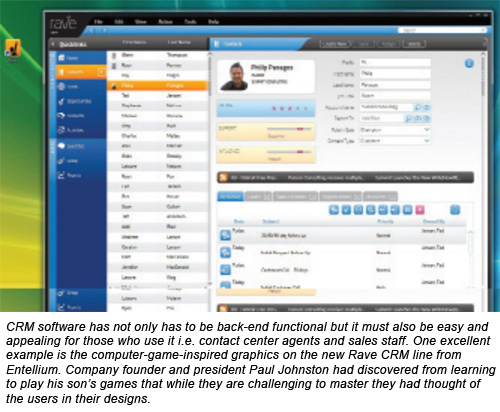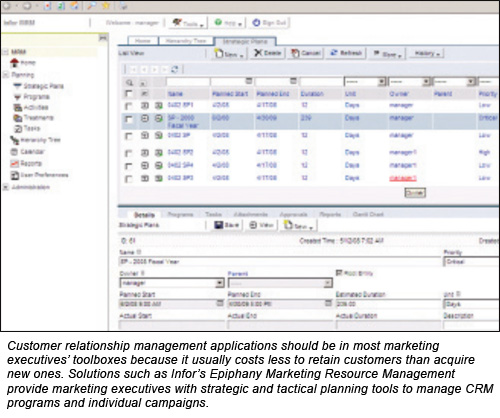|
August 2008 | Volume 27 / Number 3
CRM, BPO & Teleservices
Serving the King
Your appeals and past service to these new monarchs mean nothing. If you don't have what they want at the price they wish to pay, you are heaved out of the castle. Yet you'll be invited back should your offering meets their requirements at what they are willing to spend. So is it worth it to provide royal service via customer relationship management a.k.a. CRM? Obtaining a complete view of customers' interactions and analyzing what they want is a costly proposition. The solutions can cost as much as $1,500 to $2,000 per seat for enterprise customer premises software (CPS). Deployment can take two to three years, with a return on investment (ROI) in as long as three to five years. Newer hosted or software-as-a-service (SaaS) solutions have improved CRM viability as they can be up to 25 percent less expensive than their CPS counterparts, depending on the applications, while their deployments and ROI can be measured in months. The offsets are fewer features and less customization. Even with SaaS CRM still requires a considerable resource commitment. Not surprisingly, many enterprises are thinking twice about adopting CRM. Dimension Data, a specialist IT services and solution provider, reports that in 1997 39 percent of contact centers said they had a single view of the customer, a key CRM indicator, with 45 percent planning to create it in two years. That has dropped to 34 percent having that view in 2007.  "The rise of the Internet, and the use of different channels such as IVR and Web self-service has disrupted the unified 360 degree view of customers in CRM," observes Stephen Loring, business development manager for customer interactive solutions. "At the same time the payback period for CRM installations is too long for many of today's business managers." So why invest in CRM? "If you have customers won over you need to maintain those relationships, on the marketing side you need to get people interested in your product or service by understanding their buying behavior is, and then on the sales side you understand what the customers' needs are," explains Pete Marston, an analyst with Forrester Research. "The various CRM tools help you carry out these functions." Service and product trends There has been a steady evolution in the design and in the features of CRM solutions and services that enable organizations to meet end-customers' demanding and diverse needs faster, easier, at less expense, and with greater flexibility and scalability. The latest version of SAP CRM has an all-IP software-based, end-to-end contact center solution, including queuing and routing capabilities that eliminates the need for costly communications hardware. That feature will enable contact centers provide better service to customers through faster response times and more consistent service across contact channels while reducing IT capital and support costs. SAP CRM also makes realtime recommendations for cross selling/upselling, retention and other marketing messages or actions to boost revenues, loyalty, and customer satisfaction. There are new tools to solicit and deliver feedback from customers to facilitate immediate action on their issues. RightNow Technologies' new RightNow May '08 obtains information from satisfaction surveys conducted over the phone, via e-mail, on the Web and online chat. Feedback can also be gathered from anonymous online consumers, such as someone who recently abandoned a shopping cart. Results are compiled for trend analysis, and individual responses are included within customer profiles to enable future, more personalized service. Suppliers are devising new tools to help marketing departments to maximize results while cutting costs, which have become especially crucial in the face of a weaker economy. Infor's new Infor CRM Epiphany Marketing Resource Management (MRM) provides personalized home pages, a global calendar, and a shared marketing repository. These ensure that each member of the extended marketing organization has visibility into enterprise marketing activities and access to relevant materials. There are new applications being created that tap into the business power of social networks. Oracle is developing for Oracle CRM social networks for sales professionals, which it calls Social CRM, where the leads, campaigns, opportunities, and content are rated, tagged, and shared in social networks. Social CRM takes information that has traditionally been put into sales pipelines and places them into virtual beehives, enabling quicker and more accurate feedback and ultimately more productive selling. Suppliers are responding to greater IT and data security needs. Satuit Technologies' SatuitCRM 10.7 offers single sign-on capability that increases compliance with internal IT security policies through a partnership with Ping Identity, as well as simplifying deployment. A team-centric data privacy module lets teams and their managers to dynamically control access to customer records and sensitive data. CRM is also becoming less one-size-fits all and more customized applications and delivery methods to meet specific needs. To that end SugarCRM has come out with the Sugar Data Center Edition (DCE), which is comprised of systems management, provisioning and monitoring tools that enable centralized deployment and managing distinct Sugar CRM versions. Sugar DCE Enterprises permits large companies to manage multiple variations of SugarCRM within their firms from a single location. Sugar DCE for Partners allows resellers and hosting providers to deliver SugarCRM in a SaaS model to their customers. Forrester's Marston reports that CPS suppliers are moving away from proprietary to more open, standards-based software that permits integration with other vendors' products and which is less costly and time consuming to develop, install, maintain, and upgrade. These moves are being driven in part by competition from SaaS solutions. "The key restriction on SaaS is that its costs to users grow as its use grows," explains Marston, "whereas there are no such limitations on CPS because its costs are based on the number of licenses you acquire." Keith Dawson, senior analyst, Frost & Sullivan, sees accelerated adoption of the SaaS model, citing improved robustness and new features that are enabling these services to close the gap with CPS on functionality, and minimal risk. "The primary challenges with SaaS are not technological but cultural and managerial, i.e. who owns the system and who's going to have access to the data and budgeting resources, "says Dawson. Those new features include global support. NetSuite's new NetSuite OneWorld permits multinational and multisubsidiary companies to manage their global business operations with NetSuite's CRM, ERP (enterprise resource planning) and e-commerce suites. OneWorld provides locally and nationally-appropriate functionality, such as currency, taxation, and language along with instantaneous global rollout and compliance management. It also offers realtime marketing and services measurement. SaaS solutions now permit more analytics. The Salesforce Content feature in Salesforce Summer '08 has content analytics that permits usage metrics to be effectively tracked to determine the most frequently used content among sales reps, marketers and other users. There are limits to SaaS. Chris Wagner, Vice President, Marketing, InfoCision, points out that SaaS is a great option for organizations with up to approximately 100 contact center seats, or 3 to 4 million transactions per year and/for those that have decided against larger IT departments. Beyond that, the ownership costs and the complexity and the need to change go beyond its capability. "Whether you go for CPS or SaaS really depends on the size of your current IT department, their comfort level with the CRM that you are considering deploying, their available time, workload, and the commitment of your company to completely support a CRM development project," explains Wagner.  One option is adopting SaaS then migrating to CPS while another is using each delivery method and solution for applications that they are specifically best suited for. Several CRM suppliers make software in both modes. "More companies may be a lot more willing to take a flier on a SaaS system knowing that they can scale up or down at will," says Dawson. "If they obtain SaaS systems from CPS vendors they can migrate, needs and budget permitting, to CPS systems." Getting the most out of your CRM application When deciding what CRM services and solutions to buy, take a careful look at your needs, your budget and resources, including IT, and then at the solutions available, in that order. Do not let the technology dictate your decision. Paul Greenberg, Chief Customer Officer, BPT Partners and author of CRM at the Speed of Light, points out that there is a strong tendency, partially due to the pressures vendors place on prospective buyers, to see the technology as a panacea for CRM. The thinking, he says, goes like this 'if I use this, then I can improve relationships and engagement with my customers. Instead it should be 'if I do this and then use technology to do it, then I can improve relationships and foster engagement with my customers.' "To find the right technology tools you have to have your strategy in place and know which processes are going to be important to you to use and how you want to communicate with the customers and amongst yourselves," explains Greenberg. "Only then does 'which technology' and when that's decided 'which purveyor of that technology' become a focus." In making your choice between solutions, keep in mind the long lead time especially for CPS CRM. That means your investment will only be solving those problems that are present several months or more down the road. "Even if a CRM deployment works perfectly, when it takes say 18 months or so to achieve, a company has solved the problems it had 18 months ago and not necessarily the problems it faces today, "Ian Jacobs, senior analyst, Frost & Sullivan points out. "That is one of the greatest value propositions for hosted solutions like SaaS; because they take less time to get up and running they better help companies deal with the problems in the current reality."  Make sure that when you deploy CRM solutions, whether CPS or SaaS, that you also employ predictive analytics to anticipate customers' responses to your offers. Predictive analytics aggregate data from multiple streams, from inside and outside contact centers. They enable managers to build models on how agents should improve performance and how customers will likely do in response to your business processes. Analytics methods include business intelligence tools, call center analytics, speech analytics, and performance management. "To show to customers that you know them and are truly interested in meeting their needs you have to reasonably know, like in any good relationship, what they are going to do next," says Frost's Dawson. Bruce Pollock, Vice President, West Interactive is seeing an increase in the number of companies that are interested in analytics and predictive analytics as part of their CRM programs - to allow them to understand their customers better and treat them in a more tailored fashion. The company is engaged with clients in analyzing CRM data to find out what kinds of proactive, customer 'opt-in' outbound campaigns the client can be doing to build and maintain customer relationships, utilizing West Interactive's patented preference management system. "The foundation of CRM is all about knowing your customers better, anticipating their needs and meeting those needs with products and services tailored to benefit them," says Pollock. "Similarly it is important to communicate to customers in the channel of their choice be it live agent, speech recognition, text, video, or the Web." The following companies participated in the preparation of this article: BPT Partners Customer Effective Dimension Data Entellium Forrester Research Frost & Sullivan InfoCision Infor NetSuite Oracle RightNow Technologies Salesforce.com Satuit Technologies SugarCRM West CIS Magazine Table of Contents |





 By Brendan B. Read
By Brendan B. Read
